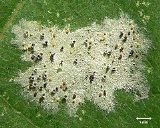
Leotiomycetes
Encyclopedia
The Leotiomycetes are a class
of ascomycete fungi. Many of them cause serious plant diseases
.
clade (inoperculate
Discomycetes). Molecular
studies have recently shed some new light to the still obscure systematics. Most scholars consider Leotiomycetes a sister taxon to Sordariomycetes
in the phylogenetic tree
of Pezizomycotina
. Its division into subclasses have received strong support by the molecular data, but the overall monophyly
of Leotiomycetes is dubious.
Class (biology)
In biological classification, class is* a taxonomic rank. Other well-known ranks are life, domain, kingdom, phylum, order, family, genus, and species, with class fitting between phylum and order...
of ascomycete fungi. Many of them cause serious plant diseases
Phytopathology
Plant pathology is the scientific study of plant diseases caused by pathogens and environmental conditions . Organisms that cause infectious disease include fungi, oomycetes, bacteria, viruses, viroids, virus-like organisms, phytoplasmas, protozoa, nematodes and parasitic plants...
.
Systematics
The class Leotiomycetes contains numerous species with an anamorph placed within the fungi imperfecti (deuteromycota), that have only recently found their place in the phylogenetic system. The older classifications placed Leotiomycetes into the DiscomycetesDiscomycetes
Discomycetes is a former taxonomic class of Ascomycete fungi which contains all of the cup, sponge, brain, and some club-like fungi. It includes typical cup fungi like the scarlet elf cup and the orange peel fungus, and fungi with fruiting bodies of more unusual shape, such as morels, truffles and...
clade (inoperculate
Operculum (botany)
An operculum, in botany, is a term generally used to describe a structure within a plant, moss, or fungus acting as a cap, flap, or lid. In plants, it may also be called a bud cap.Examples of structures identified as opercula include:...
Discomycetes). Molecular
Molecular phylogeny
Molecular phylogenetics is the analysis of hereditary molecular differences, mainly in DNA sequences, to gain information on an organism's evolutionary relationships. The result of a molecular phylogenetic analysis is expressed in a phylogenetic tree...
studies have recently shed some new light to the still obscure systematics. Most scholars consider Leotiomycetes a sister taxon to Sordariomycetes
Sordariomycetes
The Sordariomycetes are a class of fungi in the subdivision Pezizomycotina , consisting of 15 orders, 64 families, 1119 genera, and 10564 species.Sordariomycetes generally produce their asci in perithecial fruiting bodies....
in the phylogenetic tree
Phylogenetic tree
A phylogenetic tree or evolutionary tree is a branching diagram or "tree" showing the inferred evolutionary relationships among various biological species or other entities based upon similarities and differences in their physical and/or genetic characteristics...
of Pezizomycotina
Pezizomycotina
Pezizomycotina contains the filamentous ascomycetes and is a subphylum of the Ascomycota . It is more or less synonymous with the older taxon Euascomycota...
. Its division into subclasses have received strong support by the molecular data, but the overall monophyly
Monophyly
In common cladistic usage, a monophyletic group is a taxon which forms a clade, meaning that it contains all the descendants of the possibly hypothetical closest common ancestor of the members of the group. The term is synonymous with the uncommon term holophyly...
of Leotiomycetes is dubious.
Characteristics
- Most Leotiomycetes grow their asciAscusAn ascus is the sexual spore-bearing cell produced in ascomycete fungi. On average, asci normally contain eight ascospores, produced by a meiotic cell division followed, in most species, by a mitotic cell division. However, asci in some genera or species can number one , two, four, or multiples...
in apothecia (seldom cleistothecia). The asci are cylindrical, without operculumOperculum (botany)An operculum, in botany, is a term generally used to describe a structure within a plant, moss, or fungus acting as a cap, flap, or lid. In plants, it may also be called a bud cap.Examples of structures identified as opercula include:...
.
- The sporeSporeIn biology, a spore is a reproductive structure that is adapted for dispersal and surviving for extended periods of time in unfavorable conditions. Spores form part of the life cycles of many bacteria, plants, algae, fungi and some protozoa. According to scientist Dr...
s are hyalineHyalineThe term hyaline denotes a substance with a glass-like appearance.-Histopathology:In histopathological medical usage, a hyaline substance appears glassy and pink after being stained with haematoxylin and eosin — usually it is an acellular, proteinaceous material...
, of various shapes, and are released through a circular apical pore.

